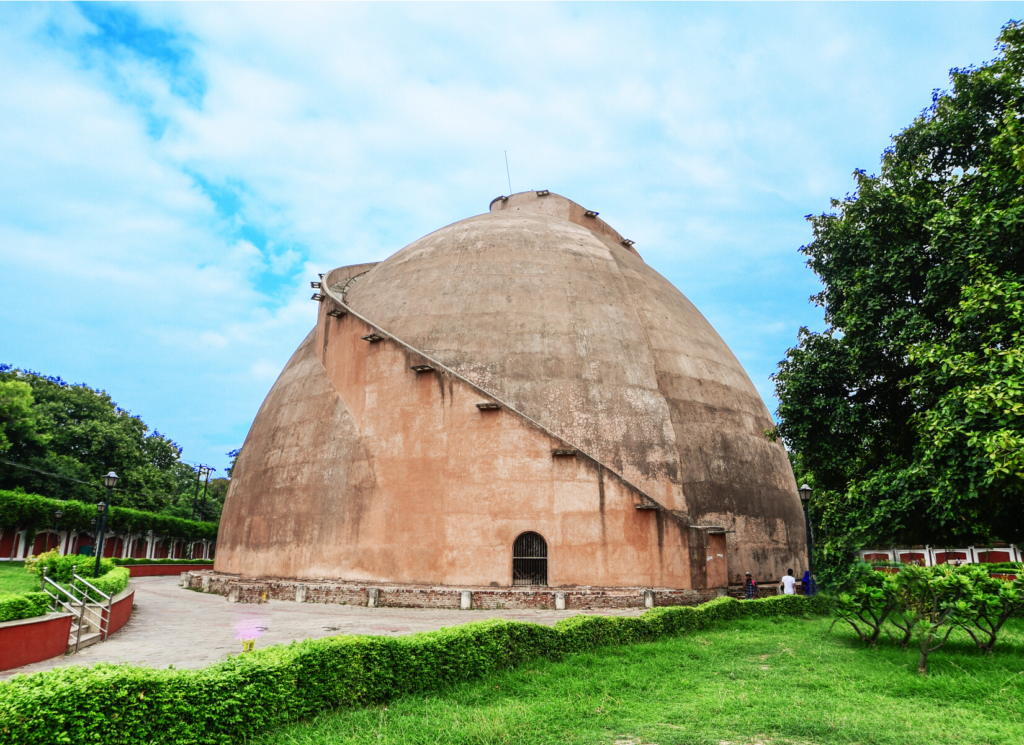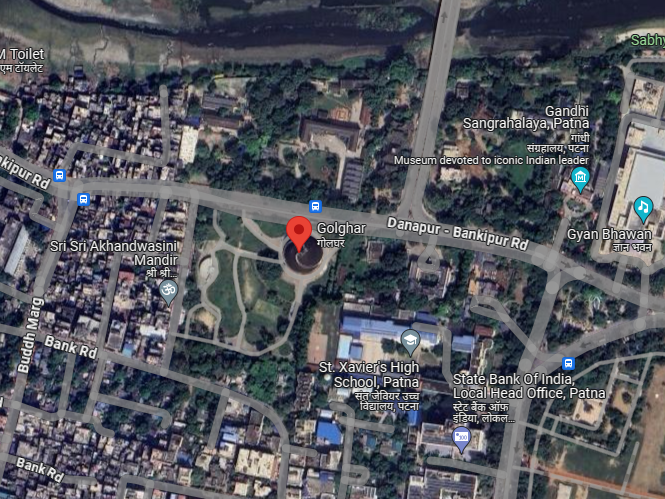

GOLGHAR: The Round House, Patna

The Golghar, also known as the Round House, is a big storage building in Patna, Bihar, India. It’s like a giant grain silo situated west of Gandhi Maidan. The Golghar in Patna was initially planned as the first of many large grain storage buildings, aimed at preventing famine in the region, but no others were ever constructed. It was designed by John Garstin of the Bengal Engineers and completed on July 20, 1786. The structure has a distinctive beehive shape. Efforts to enhance its appearance began in 2002.
General Information
Architectural style: Stupa
Location: Patna, Bihar, India
Completed: 20 July 1786
Height: 29 m
Diameter: 32m-35m
Architect: Captain John Garstin
Owner: Bihar Government
Architecture of Golghar
The Golghar is built in the style of a Stupa, a type of ancient architectural design. It stands at 29 meters tall and has thick walls measuring 3.6 meters at the base. Inside, there’s no need for pillars, and you can climb to the top using a spiral staircase with 145 steps. This staircase was cleverly designed for workers to carry grain bags up one side, unload them through a hole at the top, and then descend down the other side. From the top, you get a beautiful view of the city and the Ganges River.
Despite its size, Golghar has never been fully filled with grain. Some people say this is because of a design flaw in the doors, but visitors have found that the doors actually open outward. Currently, there are renovation efforts underway to preserve this historical monument.
History
The Gol Ghar, located in Patna, Bihar, India, is an iconic historical monument with a rich history dating back to the late 18th century.
- Construction: The Gol Ghar was built in 1786 by Captain John Garstin, an engineer serving in the British East India Company. It was constructed to address the recurring problem of famine and shortage of grains in the region. The design of the Gol Ghar is notable for its unique shape resembling a beehive.
- Purpose: Gol Ghar was initially constructed as a granary to store grains for the British Army and the local population. Its purpose was to serve as a storage facility to prevent famines by ensuring a steady supply of food grains during times of scarcity.
- Architectural Features: The Gol Ghar stands at a height of approximately 29 meters and has a diameter of around 29 meters as well. The structure is entirely made of bricks, with no supporting beams or pillars. Its design incorporates features to withstand natural disasters like earthquakes.
- Name: The term “Gol Ghar” translates to “Round House” in English, which accurately describes its circular shape. The name reflects the architectural style and function of the building.
- Tourist Attraction: Over the years, Gol Ghar has become a prominent tourist attraction in Patna, drawing visitors with its historical significance and unique architecture. Tourists can climb the spiral staircase around the exterior to reach the top and enjoy panoramic views of the city.
- Restoration and Preservation: In recent years, efforts have been made to preserve and restore Gol Ghar to maintain its historical significance. Conservation projects have been undertaken to ensure the structural integrity of the monument and to showcase it as a symbol of Patna’s heritage.
Why Gol Ghar is special?
Golghar is indeed special for several reasons:
- Architectural Significance: Golghar is an architectural marvel built by Captain John Garstin, an engineer of the East India Company, in 1786. It is a unique structure with a dome-shaped granary, which was intended to store grains for the British Army during famine conditions.
- Historical Importance: Golghar has historical significance as it was built in response to a series of famines in Bihar during the late 18th century. The structure was intended to address the problem of famine and food shortages by providing storage for grains.
- Design and Construction: The design of Golghar is notable for its unique architecture. It is a massive structure with thick walls and a spiral staircase leading to the top, offering panoramic views of the city and the Ganges River.
- Cultural Icon: Golghar has become an iconic symbol of Patna and is a popular tourist attraction. It reflects the rich history and heritage of the region and serves as a reminder of the colonial era in India.
- Tourist Attraction: Visitors to Patna often include Golghar in their itinerary due to its architectural beauty and historical significance. It is also a popular spot for picnics and leisure activities.
Location
Gol Ghar is located in Patna, the capital city of Bihar, India. It is a historic structure built during the British colonial period and is situated in the heart of the city. Gol Ghar is a popular tourist attraction and landmark in Patna.
Contact
Website: Golghar – Giant Granary in Patna | Bihar Tourism
OUR MORE WORK
I am a Diploma student of Mechanical Engineering at government polytechnic patna-7. I have completed my training of content writing from khabai tech and i am here as a content writer to write blogs.








2 comments